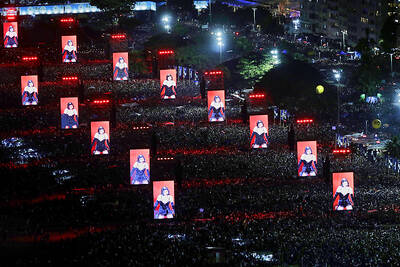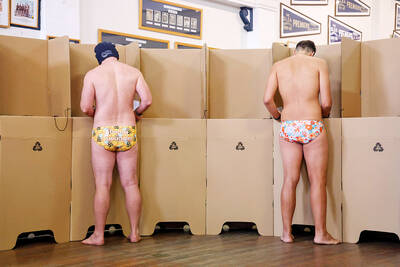From the snowbound Chinese border to holy Ganges towns, Indians yesterday began voting in a month-long general election with signs an unstable coalition may emerge in the middle of an economic slowdown.
The ruling Congress party-led coalition appears to lead against an alliance headed by the Hindu-nationalist Bharatiya Janata Party (BJP), but both may need the support of a host of smaller and unpredictable regional parties to win office.
The fear among investors is that the world’s largest democratic exercise involving 714 million voters and hundreds of parties will lead to the rise of a “Third Front” government of communist and regional groups.
The uncertain vote comes as a once-booming India reels from a crunch that has cost millions of jobs. It has ignited fears of political limbo just as India balances needs to help millions of poor with worries over its biggest fiscal gap in two decades.
The government yesterday deployed hundreds of thousands of police to protect more than 140 million people who can vote in polls that cover some of India’s poorest states hit by a four-decade old Maoist rebel insurgency.
Some election officials rode elephants to remote polling stations near the Myanmar border. Other ballots were brought by two-day sea trips to the Andaman Islands in the Bay of Bengal.
The outcome of the five-stage election will be known on May 16. India’s elections are notoriously hard to predict and polls have been wrong in the past. Exit polls are banned.
A clear win by either of the two main parties could see a rally on India’s markets, but the emergence of a weak coalition of regional and communist parties could see stocks fall by as much as 30 percent, market watchers say.
“There are widespread apprehensions that the verdict of May 16 will be hideously fractured and will inevitably lead to another election in a year or two,” Ashok Malik wrote in the Hindustan Times.
In Varanasi, the northern holy town on the Ganges River known for its Hindu gurus, many voters arrived on bicycles and bullock carts to cast electronic votes.
Voters pressed buttons with pictorial symbols of each party, after their fingers were marked with ink to avoid fraud.
“Nowadays there are so many small parties, previously there used to be only one or two big parties,” said Mohammed Mustaquim, waiting to vote in Varanasi. “This makes choosing difficult.”
Ancient caste, religious and ethnic ties will play a huge role in the vote as well as national problems like the slowdown, security fears and local issues from the building of a village water pump to problems of wild elephants trampling on villagers.
Indian Prime Minister Manmohan Singh’s center-left Congress party is wooing voters with populist measures such as food subsidies in a country were hundreds of millions of people live below the poverty line.
Singh is Congress’ official candidate. But Rahul Gandhi, the 38-year-old scion of India’s most powerful family dynasty, has become one of Congress’s main election cards, criss-crossing the nation in helicopter.
Highlighting India’s internal security woes, states such as Bihar, Chhattisgarh and Jharkhand voted yesterday in the face of stepped-up Maoist attacks on security forces. The rebels warned they would cut off the hands of those who dare vote.
Nine police protecting polls were killed by Maoist rebels in Jharkhand and Bihar states. Dozens of people have been killed in attacks in the past week.

Kehinde Sanni spends his days smoothing out dents and repainting scratched bumpers in a modest autobody shop in Lagos. He has never left Nigeria, yet he speaks glowingly of Burkina Faso military leader Ibrahim Traore. “Nigeria needs someone like Ibrahim Traore of Burkina Faso. He is doing well for his country,” Sanni said. His admiration is shaped by a steady stream of viral videos, memes and social media posts — many misleading or outright false — portraying Traore as a fearless reformer who defied Western powers and reclaimed his country’s dignity. The Burkinabe strongman swept into power following a coup in September 2022

‘FRAGMENTING’: British politics have for a long time been dominated by the Labor Party and the Tories, but polls suggest that Reform now poses a significant challenge Hard-right upstarts Reform UK snatched a parliamentary seat from British Prime Minister Keir Starmer’s Labor Party yesterday in local elections that dealt a blow to the UK’s two establishment parties. Reform, led by anti-immigrant firebrand Nigel Farage, won the by-election in Runcorn and Helsby in northwest England by just six votes, as it picked up gains in other localities, including one mayoralty. The group’s strong showing continues momentum it built up at last year’s general election and appears to confirm a trend that the UK is entering an era of multi-party politics. “For the movement, for the party it’s a very, very big

ENTERTAINMENT: Rio officials have a history of organizing massive concerts on Copacabana Beach, with Madonna’s show drawing about 1.6 million fans last year Lady Gaga on Saturday night gave a free concert in front of 2 million fans who poured onto Copacabana Beach in Rio de Janeiro for the biggest show of her career. “Tonight, we’re making history... Thank you for making history with me,” Lady Gaga told a screaming crowd. The Mother Monster, as she is known, started the show at about 10:10pm local time with her 2011 song Bloody Mary. Cries of joy rose from the tightly packed fans who sang and danced shoulder-to-shoulder on the vast stretch of sand. Concert organizers said 2.1 million people attended the show. Lady Gaga

SUPPORT: The Australian prime minister promised to back Kyiv against Russia’s invasion, saying: ‘That’s my government’s position. It was yesterday. It still is’ Left-leaning Australian Prime Minister Anthony Albanese yesterday basked in his landslide election win, promising a “disciplined, orderly” government to confront cost-of-living pain and tariff turmoil. People clapped as the 62-year-old and his fiancee, Jodie Haydon, who visited his old inner Sydney haunt, Cafe Italia, surrounded by a crowd of jostling photographers and journalists. Albanese’s Labor Party is on course to win at least 83 seats in the 150-member parliament, partial results showed. Opposition leader Peter Dutton’s conservative Liberal-National coalition had just 38 seats, and other parties 12. Another 17 seats were still in doubt. “We will be a disciplined, orderly